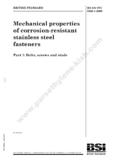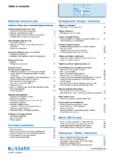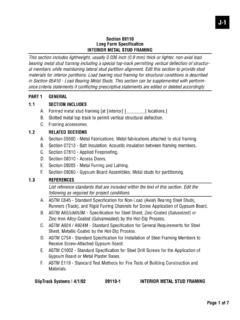Transcription of The Greasy Hands Garage Guide to Rebuilding the Triumph …
1 The Greasy Hands Garage Guide to Rebuilding the Triumph A-Type Overdrive part 1 Disassembly Larry Young and Sam Clark, Green Country Triumphs Revised: May 5, 2006 The following technical documentation was gathered during the rebuild of two overdrive transmissions: one from a TR3 (no. 22/1374) and one came out of a TR4 (no. 28/1447). The 22 indicates a 22% overdrive, which is the ratio used for all A-type overdrives fitted to the TRs, and model 22/1374 was used by Triumph on the TR3 and early TR4 (thru October 1964). The 28 indicates a 28% overdrive, and model 28/1447 was never supplied by the factory for the TR4. This overdrive may have come from an Austin Healey. Other than the gear ratio, this model appears to be the same as model 22/1753 which was fitted to most of the IRS TRs. This one appears to have been setup with a cable for manual shifting. This unit was a mess. Some of the disassembly steps do not have to be in the exact order given below, but this is the order we like to use.
2 Step 1 Remove top cover and drain transmission and overdrive Remove the top cover from the transmission by loosening the 8 bolts and drain the oil out of the transmission and the overdrive. Both of our overdrives had a lot of sludge (see photo). Step 2 Remove the Solenoid It s tempting to use the solenoid as a handle, but don t. The aluminum bracket it mounts on is weak and replacements cost almost $100. We remove the solenoid next by removing the two screws and the actuating lever. Step 3 Remove Overdrive from Transmission If the overdrive has been used recently, you should actuate it a few times to bleed off any residual pressure. Then remove the overdrive from the transmission. Eight springs hold the overdrive in the disengaged position. Remove the nuts from the short studs first, and then loosen the nuts on the long studs. Make sure the springs push the overdrive away from the transmission as the nuts are loosened.
3 If the two are stuck together, you don t want them to come apart all at once after all nuts are removed. After the nuts are removed, lift the overdrive away from the transmission. If you are also Rebuilding the transmission, then remove the adapter plate from the back of the transmission and the pump cam on the transmission output shaft. Step 4 Remove Operating Valve The operating valve is beneath the plug on the top of the overdrive. Remove the plug and extract the spring, plunger and ball. Leave the valve itself until after the accumulator piston is removed in the next step. The valve and associated parts are shown in the photo below. The respective pieces from left to right are the valve, ball, plunger, spring, washer and plug. The small hole (yellow arrow) releases pressure when shifting out of overdrive. Make sure the hole is not filled with sludge. You can check the operation of the unit by reinstalling the ball, applying air pressure at the plug hole and manually activating the operating valve.
4 The operating pistons should move the sliding assembly forward until the brake ring is contacted. Step 5 Remove the Accumulator Piston The accumulator contains a piston and one or two heavy springs. When at full pressure, the spring is compressed to the point that oil leaks out the pressure relief holes on the sides of the accumulator. When compressed the spring force is almost 1000 lb, so you must be careful to release the spring slowly. The accumulator cover is fastened with two nuts on short studs and with two long bolts. Remove the nuts first, then loosen the two bolts evenly so that the cover plate follows the bolts, decompressing the spring (right photo). Once the plate is off and the springs withdrawn, the piston can be removed. Air pressure can be used to move the piston. Temporarily reinstall the ball in the operating valve, then (see photo) apply pressure at the operating valve plug hole.
5 This initial movement can help to dislodge a stubborn piston. Sometimes air pressure will blow it completely out, so use a towel to catch it. You can now remove the operating valve. The early overdrives (models 22/1374 and 22/1712) have a large accumulator and piston. The piston has threads that are 3/8x24 so it can be removed by prying on the head of a long bolt screwed into the piston.. The later overdrives (models 22/1753 and 22/1985) with small accumulator have a sleeve and spacer tube in addition to the piston. If air pressure does not remove all three pieces, you can make an extraction tool using a rubber expansion plug (like a drain plug for a boat). A good hardware store will stock rubber expansion plugs in a variety of sizes. The following photos show the assembly from our bodged TR4 unit. The piston rings on this unit came out in pieces. Step 6 Remove the Operating Pistons The operating pistons are removed by bending back the lock tabs and removing the four nuts and two bridge pieces.
6 The pistons can then be extracted. The left photo shows the early style piston with steel rings (model 22/1374), while the right photo shows the later style with rubber o-rings (models 22/1712, 22/1753 and 22/1985). Step 7 Remove Pump Before removing the pump, you must remove the check valve assembly (plug, plunger, spring and ball). The early units had a 5/16 inch ball for both the operating valve and the pump check valve, whereas the later units (nos. 22/1753 and 22/1985) used a 1/4 inch ball in the check valve. After removing the check valve, remove the two screws and plug at the bottom of the pump. We needed an impact screw driver (a very handy tool) to remove one of the screws. The plug and pump body have 7/16x20 threads, so we made a puller by adding some extra threads to a long bolt. Step 8 Separate the Housings The brake ring is sandwiched between the main housing and rear housing.
7 The pieces are separated by removing 6 nuts. All three pieces should come apart, but you may need to tap on the edge of the brake ring to make that happen. Just be careful not to damage the mating surface, because no gasket is used here. Be sure not to lose the two main shaft washers on the back side of the main housing. The picture to the right shows the housing for our bodged TR4 overdrive. The flange of the main housing was broken off and the housing itself was cracked. We suspect the overdrive was dropped. The grease in the broken area indicates it may have been put together this way. Since this is a valuable piece, we had it repaired at a machine shop. Step 9 Remove Sliding Assembly, Gears and Unidirectional Clutch After the brake ring has been removed the sliding assembly (thrust ring, sliding member and bearing) can be removed. If the unit has been sitting, the inner friction lining may be stuck to the annulus, but tapping with a small hammer should free it.
8 You can then remove the planet gear assembly and unidirectional clutch. The sun gear for a 22% overdrive can be withdrawn from the front or back, but for a 28% it can only be withdrawn from the back. The bearing in the sliding assembly is expensive. If it rolls smoothly, you may wish to reuse it. If you replace the bearing, you must remove the snap ring (circlip) that secures the thrust ring to the sliding member and the snap ring which holds the bearing. The photos below show some of the problems you may encounter. We find that the washer in the planet gear assembly is frequently broken or missing. In one of our overdrives we found only one small piece of this washer inside the annulus. The other one had one piece missing, but the piece was found intact. The photo on the right shows a broken unidirectional clutch from a previous rebuild. This damage was likely caused by engaging the overdrive in reverse.
9 Luckily, the gears were not damaged in any of these units. Step 10 Remove Annulus and Rear Bearings You must remove the speedometer gear and rear flange before removing the annulus (see transmission article). The annulus can then be pressed out of the housing. Remove the seal and tap the rear bearing out of the housing. The front bearing can be removed using a press.










